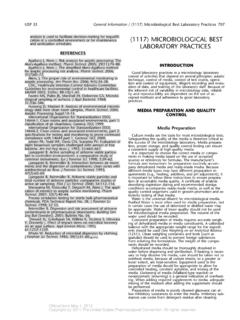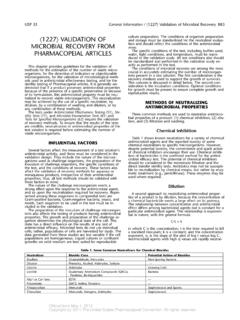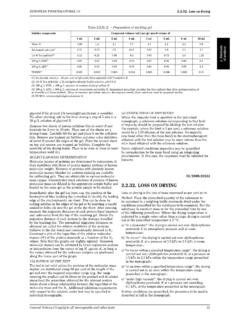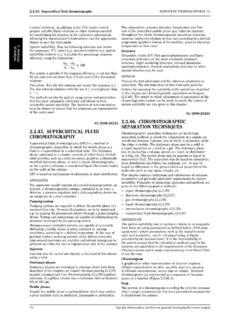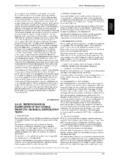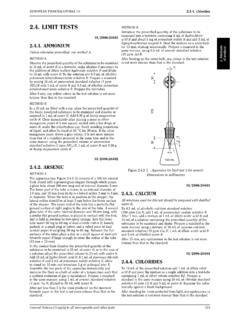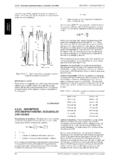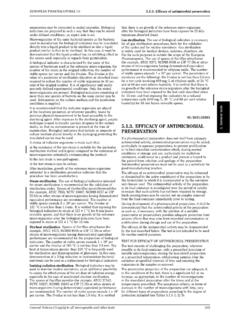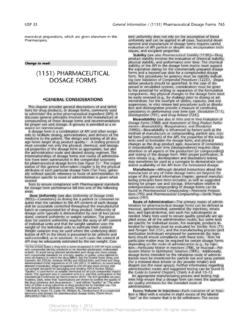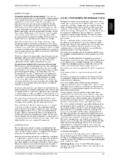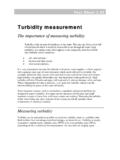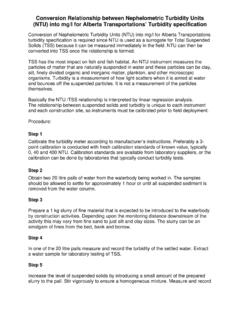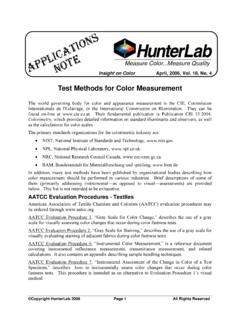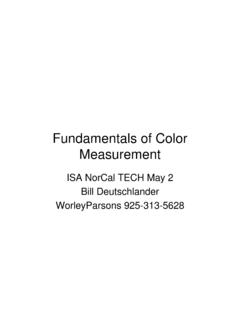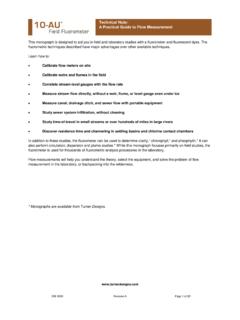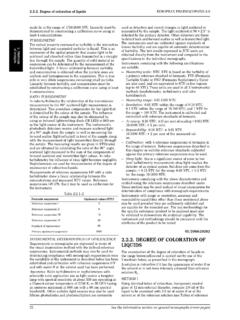Transcription of 2.2. PHYSICAL AND PHYSICOCHEMICAL METHODS
1 EUROPEAN PHARMACOPOEIA Clarity and degree of opalescence of PHYSICAL ANDPHYSICOCHEMICAL METHODS01/2008 CLARITY AND DEGREE OFOPALESCENCE OF LIQUIDSVISUAL METHODU sing identical test-tubes of colourless, transparent, neutralglass with a flat base and an internal diameter of 15-25 mm,compare the liquid to be examined with a reference suspensionfreshly prepared as described below, the depth of the layerbeing 40 mm. Compare the solutions in diffused daylight 5 minafter preparation of the reference suspension, viewing that reference suspension I can readily be distinguishedfromwater R, and that reference suspension II can readily bedistinguished from reference suspension its clarity is the same as thatofwater Ror of the solvent used when examined under theconditions described above, or if its opalescence is not morepronounced than that of reference suspension sulfate Rinwater Rand dilute to mL with the samesolvent.
2 Allow to stand for 4-6 flask, dissolve g ofhexamethylenetetramine Rin mL ofwater opalescent suspension(formazin suspension). To thehexamethylenetetramine solution in the flask add mL ofthe hydrazine sulfate solution. Mix and allow to stand for 24 suspension is stable for 2 months, provided it is stored in aglass container free from surface defects. The suspension mustnot adhere to the glass and must be well mixed before of opalescence. Dilute mL of the primaryopalescent suspension to mL withwater is freshly prepared and may be stored for up to 24 suspensions. Prepare the reference suspensionsaccording to Table Mix and shake before of mLWater mL mLTurbidity standard. The formazin suspension prepared bymixing equal volumes of the hydrazine sulfate solution and thehexamethylenetetramine solution is defined as a 4000 NTU(nephelometric turbidity units) primary reference suspensions I, II, III and IV have values of 3 NTU,6 NTU, that can be used to prepare stable, diluted turbiditystandards are available commercially and may be used aftercomparison with the standards prepared as has several desirable characteristics that make it anexcellent turbidity standard.
3 It can be reproducibly preparedfrom assayed raw materials. The PHYSICAL characteristics makeit a desirable light-scatter calibration standard. The formazinpolymer consists of chains of different lengths, which foldinto random configurations. This results in a wide assay ofparticle shapes and sizes, which analytically fits the possibilityof different particle sizes and shapes that are found in thereal samples. Due to formazin s reproducibility, scatteringcharacteristics and traceability, instrument calibrationalgorithms and performance criteria are mostly based on METHODSINTRODUCTIONThe degree of opalescence may also be determined byinstrumental measurement of the light absorbed or scatteredon account of submicroscopic optical density inhomogeneitiesof opalescent solutions and suspensions. 2 such techniques arenephelometry and turbidimetry. For turbidity measurement ofcoloured samples, ratio turbidimetry and nephelometry withratio selection are light scattering effect of suspended particles can bemeasured by observation of either the transmitted light(turbidimetry) or the scattered light (nephelometry).
4 Ratioturbidimetry combines the principles of both nephelometry andturbidimetry. Turbidimetry and nephelometry are useful forthe measurement of slightly opalescent suspensions. Referencesuspensions produced under well-defined conditions mustbe used. For quantitative measurements, the construction ofcalibration curves is essential, since the relationship betweentheopticalpropertiesofthesuspensi onandtheconcentrationof the dispersed phase is at best determination of opalescence of coloured liquids is donewith ratio turbidimeters or nephelometers with ratio selection,since colour provides a negative interference, attenuating bothincident and scattered light and lowering the turbidity effect is so great for even moderately coloured samples thatconventional nephelometers cannot be instrumental assessment of clarity and opalescenceprovides a more discriminatory test that does not depend onthe visual acuity of the analyst.
5 Numerical results are moreuseful for quality monitoring and process control, especiallyin stability studies. For example, previous numerical data onstability can be projected to determine whether a given batchof dosage formulation or active pharmaceutical ingredient willexceed shelf-life limits prior to the expiry a suspension is viewed at right angles to the directionof the incident light, the system appears opalescent due tothe reflection of light from the particles of the suspension(Tyndall effect). A certain portion of the light beam enteringa turbid liquid is transmitted, another portion is absorbedand the remaining portion is scattered by the suspendedparticles. If measurement is made at 90 to the light beam,thelightscatteredbythesuspendedpart iclescanbeusedfor the determination of their concentration, provided thenumber and size of particles influencing the scattering remainconstant.
6 The reference suspension must maintain a constantdegree of turbidity and the sample and reference suspensionsmust be prepared under identical conditions. The Tyndalleffect depends upon both the number of particles and theirsize. Nephelometric measurements are more reliable in lowturbidity ranges, where there isa linear relationship betweennephelometric turbidity unit (NTU) values and relative detectorsignals. As the degree of turbidity increases, not all the particlesare exposed to the incident light and the scattered radiationof other particles is hindered on its way to the detector. Themaximum nephelometric values atwhich reliable measurementscan be made lie in the range of 1750-2000 NTU. Linearity mustbe demonstrated by constructing a calibration curve using atleast 4 optical property expressed as turbidity is the interactionbetween light and suspended particles in liquid.
7 This is anexpression of the optical property that causes light to bescattered and absorbed rather than transmitted in a straightline through the sample. The quantity of solid material insuspension can be determined by the measurement of thetransmitted light. A linear relationship between turbidity andconcentration is obtained when the particle sizes are uniformand homogeneous in the suspension. This is true only in veryGeneral Notices (1) apply to all monographs and other Degree of coloration of liquidsEUROPEAN PHARMACOPOEIA suspensions containing small particles. Linearity betweenturbidity and concentration must be established by constructinga calibration curve using at least 4 TURBIDIMETRYIn ratio turbidimetry the relationship of the transmissionmeasurement to the 90 scattered light measurement isdetermined. This procedure compensates for the light thatis diminished by the colour of the sample.
8 The influence ofthe colour of the sample may also be eliminated by usingan infrared light-emitting diode (IR LED) at 860 nm as thelight source of the instrument. The instrument s photodiodedetectors receive and measure scattered light at a 90 anglefromthesampleaswellasmeasuringthefo rward scatter (lightreflected) in front of the sample along with the measurement oflight transmitted directly through the sample. The measuringresults are given in NTU(ratio) and are obtained by calculatingthe ratio of the 90 angle scattered light measured to thesum of the components of forward scattered and transmittedlight values. In ratio turbidimetry the influence of stray lightbecomes negligible. Nephelometers are used for measurementsof the degree of opalescence of colourless of reference suspensions I-IV with a ratioturbidimeter show a linear relationship between theconcentrations and measured NTU values (see Table ).
9 Reference suspensions I-IV (Ph. Eur.) may be used as calibratorsfor the suspensionsOpalescent values (NTU)Reference suspension I3 Reference suspension II6 Reference suspension III18 Reference suspension IV30 Standard of opalescence60 Primary opalescent suspension4000 INSTRUMENTAL DETERMINATION OF OPALESCENCER equirements in monographs are expressed in terms ofthe visual examination method with the defined referencesuspensions. Instrumental METHODS may also be used fordetermining compliance with monograph requirements oncethe suitability of the instrument as described below has beenestablished and calibration with reference suspensions I-IV andwithwater Ror the solvent used has been Ratio turbidimeters or nephelometers withselectable ratio application use as light source a tungsten lampwith spectral sensitivity at about 550 nm operating at a filamentcolourtemperatureof2700K,orIRLED havinganemissionmaximum at 860 nm with a 60 nm spectral bandwidth.
10 Othersuitable light sources may also be used. Silicon photodiodes andphotomultipliers are commonly used as detectors and recordchanges in light scattered or transmitted by the sample. Thelight scattered at 90 is detected by the primary detectors are those to detect back and forward scatter aswell as transmitted light. The instruments used are calibratedagainst standards of known turbidity and are capable ofautomatic determination of turbidity . The test results expressedin NTU units are obtained directly from the instrument andcompared to the specifications in the individual complying with the following specifications aresuitable. Measuring units: NTU. NTU is based on the turbidity ofa primary reference standard of formazin. FTU (FormazinTurbidity Units) or FNU (Formazin Nephelometry Units) arealso used, and are equivalent to NTU in low regions (up to40 NTU). These units are used in all 3 instrumental METHODS (nephelometry, turbidimetry and ratio turbidimetry).
